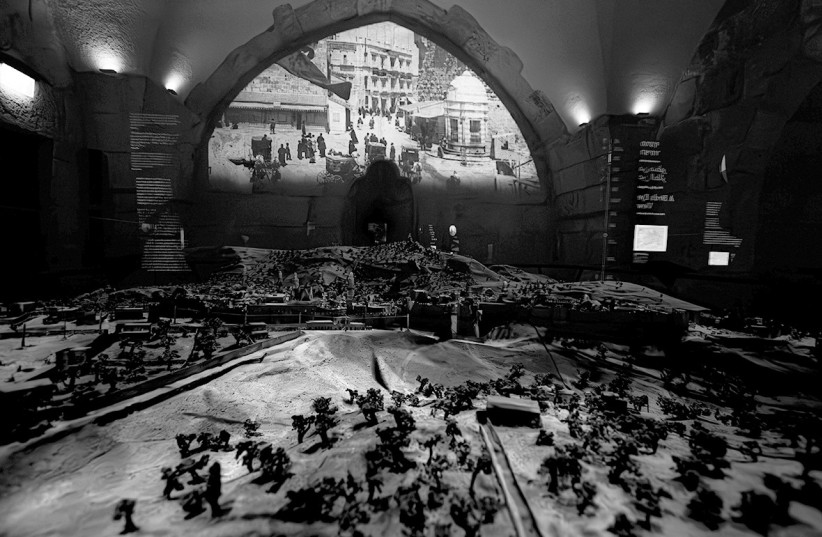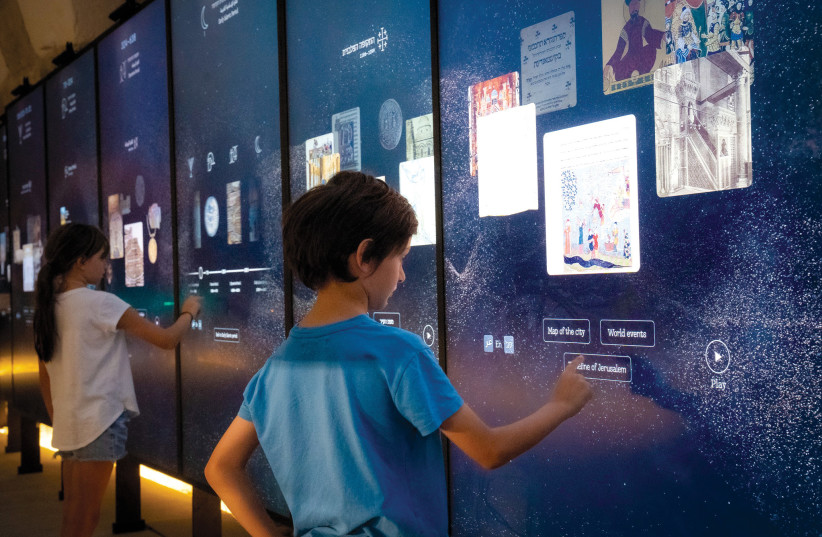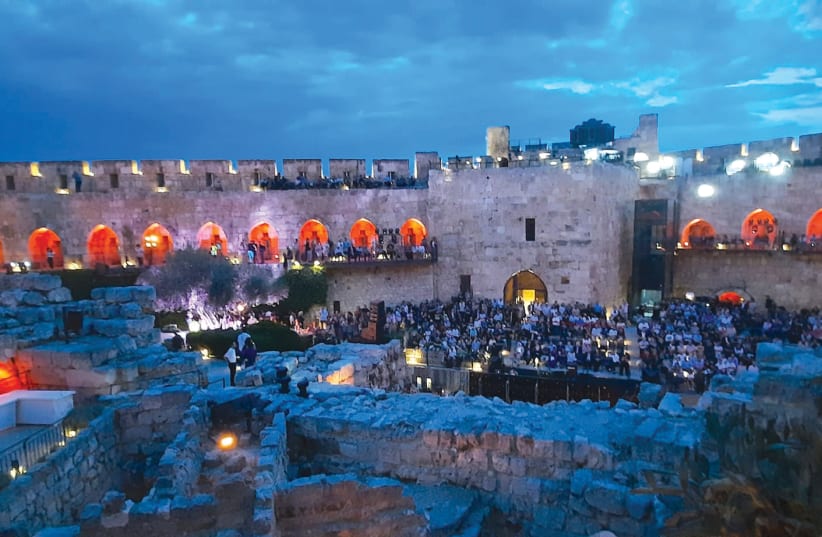“Jerusalem is a port city on the shore of eternity” – Yehuda Amichai
Twenty meters from Jaffa Gate. 3,160 km. from Clermont-Ferrand, France. 1.5 km. from the protests at the President’s Residence in Jerusalem. 29 km. from Hebron. 13,003 km. from Drake’s Passage, the most powerful convergence of seas. 2,419 km. from Vienna. 4,681 km. from Varanasi, India. 9,497 km. from the White House. 6,338 km. from Mount Qingcheng, China. 1,239 km. from Mecca. And 577 meters from the Western Wall.
Therein lies the Tower of David. The center of Jerusalem. West to east. East to west. By extension, the navel of the universe. Die ganze Welt in einem Kleberblat. The entire world in a cloverleaf.
The rich history of Jerusalem's Tower of David Museum
Since 1989, the Tower of David Museum has revolutionized, metamorphosed itself. It now connects all of those places, drawing parabolic lines on an imaginary map, bending and curving at the seams, and carries everyone who enters its sphere along for the ride. When one stands at the top of the ancient Tower of David citadel, which the museum has built itself around, one gets a bird’s eye view of the entirety of Jerusalem. A bird’s eye view. Five hundred million birds make their way over it every year. Jerusalem is the second-busiest migratory highway in the world. Songbirds, hoopoes, wagtails, sunbirds, doves. Their migration patterns are as intricate and complex as the city’s changing landscape beneath them throughout the past 4,000 years. Must seem like nothing to them. It means everything to us. Connecting the sky to the land, one continent to another, each time period to the others, every person to one another. That is the role the Tower of David Museum has taken on.
The people at the forefront of this monumental connection have all faced their fair share of challenges over the years. Many new features were constructed, throwing the museum over its head. The massive renovation has taken more than a decade of planning and three years of construction, with $50 million of funding by Dame Vivien Duffield through the Clore Israel Foundation, together with the support of the Jerusalem Municipality; the Ministry of Jerusalem and Jewish Tradition; the Ministry of Heritage; the Ministry of Tourism; the Patrick and Lina Drahi Foundation; Keren Hayesod; The Jerusalem Foundation; the American Friends of Museums in Israel; and the P. Austin Family Foundation.


The team welcomed visitors to the grand opening on June 1. A true labor of love for “almost 4,000 years’ worth of Jerusalem’s history in this complex,” Caroline Shapiro, director of External Affairs, tells The Jerusalem Report. “Complex” is a good word. A love for the city’s identity in all its prisms.
“[The renovation is] split into four things: visitor flow and the new entrance pavilion; conservation of the actual citadel – the stones, the minaret, and the walls; a complete renewal of the permanent exhibition; and making the museum accessible,” Shapiro explains.
I like to think of Jerusalem as a cavalcade of truths, sometimes clashing between one another, hurting, using, abusing, inspiring, nourishing, but ultimately running toward a nonexistent finish line. As I walk around the museum site, the sense of the labyrinth around me – the stones’ cavities, almost as if each one was carefully constructed over a lifetime, containing 2,800 years’ worth of epochs – mirrors the coexistence and the interweaving of all of the people who lived in the city. The mingling, the storytelling, the sharing. How does one represent this, while also making it digestible for everyone – and the museum truly means “everyone” in every sense of the word – to ingrain its profound meaning?
Eilat Lieber, director and chief curator of the museum, beckons to me, visibly excited about showing the fruits of her efforts to anyone who wants to see it, and making it interesting for those who don’t. Her museology stems from a rather offhand, yet motivating interaction with her son, who said that “history and archaeology are boring.” That shifted her focus to ensuring that every age group can take something away from the museum experience.
“It’s not just history and archaeology, it’s culture, people, architecture all over, communities, food – everything is connected to the same core that says, ‘This is a meeting point for things all over the world,’” she tells The Report. “The words of prophets that spoke in Jerusalem 3,000 years ago are still relevant to so many people. We found ways to bring those stories to the public. There’s no other place that represents all the layers of Jerusalem’s story like the Tower.”
As I walk up the stairs to one of the balconies near the top of the site, I spot Reut Kozak, head of Access and Inclusion, guiding two young girls in electric wheelchairs and their families, right next to the accessibility elevator the museum carefully constructed so as to not interfere with the walls of the site. Also co-chair of the national forum for museums on disabilities and special needs, she has been making a great effort to include the marginalized, who are often considered as an afterthought when it comes to public spaces, let alone ones in which preservation is such an important aspect.
“We are in an archaeological and historical site, a place with ruins from the periods of the First and Second Temples, and the Romans, Byzantines, Crusaders, etc.,” Kozak says. “Each one of them has built a fortress designed for defense and fortifications. They wanted people to not come here, to back off. We’re doing the opposite. We’re opening the museum, welcoming people with inclusive arms and using it as a platform for conversation.”
It is about working with the museum. Not against it. Kozak says, “We’re working on creating a digital 360-degree tour of the observation for people in wheelchairs; sensory guides for those with high sensitivity to sound or light; a complete audio-descriptory guide of the museum for the blind; and a sign language-based visual guide for deaf folks, who have no option like that in Israel.
“We realized that a huge problem for those with special needs is that after age 21, they’re practically by themselves. We have to open up museums for them too, even though they’re not necessarily a part of the education department. So that’s what we’re doing.”
For Lieber, realizing her ambitions was also about understanding the difference between simply delivering information and conveying a message. “The previous museum was a state-of-the-art museum. You’d be able to find information; but to us, it wasn’t about information. It was about meaning and about engaging people,” she says.
And the message is palpably present, flowing in the museum’s arteries, paving a way and shining a light to where I’m headed. It could be the “Sands of Time,” as Yoav Cohen, the director of Creative and Digital Media, calls it. His slick, minimalist takes, repeated iconology, and groundbreaking interactive technology are making huge strides in wowing the crowds and capturing all their attention. “We wanted to reflect the idea of time in the wave of sand. An organic motion,” he explains.
Concept and permanent exhibition designer Tal Roih de Lange says, “In order to enhance the citadel, we wanted to create an exhibition that contrasts it – light, modern, using modern materials, minimalistic, elegant, interactive and dynamic, which makes learning an enjoyable experience. We wanted to make the exhibitions multi-layered; you can go deeper or you can see it in a quick glance, but you’ll still get the whole experience.”
Museum conservator Orna Cohen restored Stephen Illés’s model of Jerusalem. It had been presented at the Vienna World’s Fair in 1873, toured European cities, and was sold in 1878. It was eventually found in 1984 by Moti Yair in the attic of the Geneva University Library. A story of pure determination, Illés created the model with no aerial photographs of Jerusalem, sketched the area, went back to his workshop and crafted “each piece, each building or fragment like jewelry – carefully cutting and attaching and drawing and painting.” That’s how Cohen describes it, clearly allied with Illés and his determination, meticulously working on the model. A product of human effort that has traveled the world, seen by so many different people, and ended up back in Jerusalem. The most revolutionary innovation of that era included in the model was the telegraph poles, lined throughout Jaffa like the veins of the city, allowing that same link between countries and people.


Guiding me through the museum’s galleries are Ravit Nenner-Soriano, curator of Archaeology, whose fascination about the artifacts is addicting; and Tal Kobo, curator of the Permanent Exhibition, on whom the platform, the positive outlook and the possibilities for meaningful discussions arising from the museum have clearly had a profound effect.
“The museum is the center of Jerusalem, also in its ideas. It is both conceptually and physically connecting the past and the present,” says Kobo. Even with something as simple as the new entrance pavilion, “You now enter the museum from the west. We wanted to be a new gate to the Old City to the east, and make it our last gallery. People will enter the Old City – it doesn’t matter if they go to the Jewish Quarter, the Christian Quarter or the Muslim Quarter – they’ll now come with more knowledge. And we believe that knowledge is the key for conversation, for tolerance, to know about the other. That’s what we’re trying to show here.”
Kobo explains: “In the museum there’s a continuous dialogue between the past and the present. The best example is looking outside the glass windows. You’re looking here at cups and pottery thousands of years ago, but you’re also looking right through to the windmill and the first neighborhood of the city, for example.”
Tracing sanctity. Delving headfirst into coexistence between supposedly different people. Realizing that at the end of the day, they may not be so different after all. “Jerusalem is many, many things. We’re looking for the tangent points between the religions. It’s important for us that each person could find themselves here, to think this is about them, but at the same time to see that there are other people here. That it all connects.”
Ancient Muslim coins with a menorah symbol engraved from the 8th century. A stone plaque found in Canaan with symbols of an Egyptian goddess. The prayers from the Western Wall, the muezzin call, and the bells from the Church of the Holy Sepulcher intersecting in the films. The incredible 5th gallery that maps onto a ceiling of an old guardroom, a seven-minute animation by the absurdly talented filmmaker David Polonsky that converges the three Abrahamic religions’ holiday calendar.
“Any day you walk into the Old City, you can see somebody celebrating something,” says Shapiro as I try to process the repetitive, lucid and saturated animations encompassing me from all over. Walking into a kaleidoscope would be the closest thing to this. But that might be what all of us are doing by just existing in this city.
“We hope people can leave the museum slightly more educated, slightly more knowledgeable, understanding that Jerusalem of today happens on the back of 4,000 years of history, of cultures, of rulers. Then we’ll have been able to do something that will hopefully help dialogue and put things in context,” she says.
The grand opening on June 1 was a promising and hopeful event. Seeing the glimmer in the staff’s eyes made all the difference. Moshe Lion, the mayor of Jerusalem, raved about the museum as the honorary speaker. “Jerusalem is like no other city, and the Tower of David Jerusalem Museum is like no other city museum,” he said. “The new Tower of David Jerusalem Museum at the Jaffa Gate will serve as the new gateway to Jerusalem for the millions of visitors, tourists and pilgrims who want to explore the city’s rich and complex history before visiting the religious sites and ancient alleyways of the Old City.”
As he was speaking, a flock of swifts, who spend most of their lives in flight, entered the corner of my vision, dancing alongside the minaret across the night sky – soon to be illuminated by the museum’s dazzling light show – on their way to migrate, gather and nest on top of the Western Wall. Bringing yet another generation, shape and layer to this timeless apeirogon. And Eternity is Jerusalem. ■
[Note: An apeirogon is a geometric shape with an infinite number of countable sides.]
